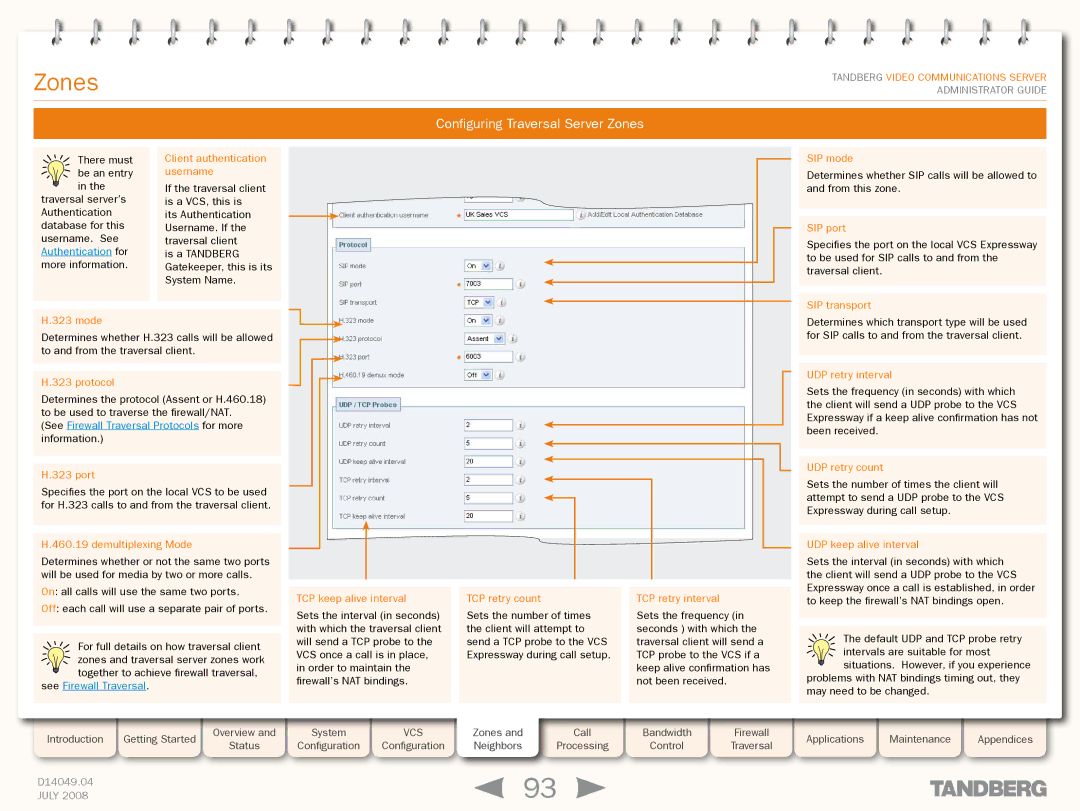
Grey Headline (continued)
Zones
TANDBERG VIDEO COMMUNICATIONS SERVER ADMINISTRATOR GUIDE
Configuring Traversal Server Zones
There must |
| Client authentication |
be an entry |
| username |
in the |
| If the traversal client |
traversal server’s |
| is a VCS, this is |
Authentication |
| its Authentication |
database for this |
| Username. If the |
username. See |
| traversal client |
Authentication for |
| is a TANDBERG |
more information. |
| Gatekeeper, this is its |
|
| System Name. |
|
|
|
H.323 mode
Determines whether H.323 calls will be allowed to and from the traversal client.
H.323 protocol
Determines the protocol (Assent or H.460.18) to be used to traverse the firewall/NAT.
(See Firewall Traversal Protocols for more information.)
H.323 port
Specifies the port on the local VCS to be used for H.323 calls to and from the traversal client.
H.460.19 demultiplexing Mode
Determines whether or not the same two ports will be used for media by two or more calls.
On: all calls will use the same two ports.
Off: each call will use a separate pair of ports.
For full details on how traversal client zones and traversal server zones work
![]() together to achieve firewall traversal, see Firewall Traversal.
together to achieve firewall traversal, see Firewall Traversal.
TCP keep alive interval
Sets the interval (in seconds) with which the traversal client will send a TCP probe to the VCS once a call is in place, in order to maintain the firewall’s NAT bindings.
TCP retry count
Sets the number of times the client will attempt to send a TCP probe to the VCS Expressway during call setup.
TCP retry interval
Sets the frequency (in seconds ) with which the traversal client will send a TCP probe to the VCS if a keep alive confirmation has not been received.
SIP mode
Determines whether SIP calls will be allowed to and from this zone.
SIP port
Specifies the port on the local VCS Expressway to be used for SIP calls to and from the traversal client.
SIP transport
Determines which transport type will be used for SIP calls to and from the traversal client.
UDP retry interval
Sets the frequency (in seconds) with which the client will send a UDP probe to the VCS Expressway if a keep alive confirmation has not been received.
UDP retry count
Sets the number of times the client will attempt to send a UDP probe to the VCS Expressway during call setup.
UDP keep alive interval
Sets the interval (in seconds) with which the client will send a UDP probe to the VCS Expressway once a call is established, in order to keep the firewall’s NAT bindings open.
The default UDP and TCP probe retry intervals are suitable for most
![]() situations. However, if you experience problems with NAT bindings timing out, they may need to be changed.
situations. However, if you experience problems with NAT bindings timing out, they may need to be changed.
Introduction | Getting Started |
| Overview and |
| System |
| VCS | Zones and | Call |
| Status |
| Configuration |
| Configuration | Neighbors | Processing | ||
|
|
|
|
| |||||
|
|
|
|
|
|
|
|
|
|
D14049.04 |
|
|
|
|
|
|
| 93 | |
JULY 2008 |
|
|
|
|
|
|
| ||
Bandwidth Firewall
Control Traversal
Applications Maintenance Appendices
